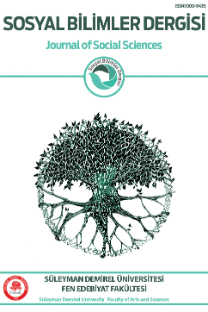Bektaşi İkonografisi Üzerine Bir Deneme: Hacı Bektaş Veli Müzesi'ndeki Figürlü Keşkül-ü Fukaralar
Keşkül adı verilen dilenme ve yemek kapları tarikat litürijisinde önemli bir yere sahiptir. İslam’da hoş karşılanmasa da dilenme birçok tarikat için önemli bir ritüeldir. Bektaşilik’te de büyük sufiler müritlerinin kibirlerini kırmak ve nefislerini terbiye etmek amacıyla onları dilendirmiştir. Bu nedenle dilenmenin vazgeçilmez parçası olan keşküllerin tasarımına önem verilmiş ve üzerleri tarikatın sembol dünyasında yeri olan derviş, kuş, ejder, arı gibi figürlerle bezenmiştir. Tarikatın önemli kişilerine ait menakıbnâme ve velâyetnâmelerinde sıklıkla rastlanan bu figürler tekke-tasavvuf edebiyatındaki nefeslerde karşımıza çıkarak, bu imgelerin anlamlandırılmasına olanak verir.
An Essay on Bektashi Iconograhy: Kaskhül-u Fukara's in Museum of Hajji Bektash Veli
Kaskhūl, the particular name used for vessels for food and begging, has a prominent place in the liturgy of religious order. Although, in Islam, begging is not approved at all, it is considered a rather significant ritual in numerous religious orders. In Bektashies, for example, the great sufis made their followers beg in order to educate the self, and discipline the arrogance. Therefore, scheming of keskhul, being one of the most the requisite objects in terms of begging, was indeed a remarkably significant matter. Keskhūls were often adorned with such motives as dervishes, birds, dragons, and bees, which are significant in the symbolic world of the religious order. These motives, which we often find in the menakıbnâmes and velâyetnâmes of the high-ranking people in the religious order, also appear in the poems, in the literature of dervish convent or mysticism in general, and these verses offer us the chance to understand the meaning of these images.
- ISSN: 1300-9435
- Yayın Aralığı: Yılda 3 Sayı
- Başlangıç: 1995
- Yayıncı: Süleyman Demirel Üniversitesi, Fen-Edebiyat Fakültesi
Sayıdaki Diğer Makaleler
1651 Yılında Kayseri Kalesinin Kuşatılamsı ve Kürd Mehmet Ağa
Atatürk Döneminde Bodrum'un Nüfus Yapısı (1923-1938)
Siyasi Görüşlerin Tüketici Tutumlarına Etkisi
Ahmet Hüsrev EROĞLU, Sumru BAYRAKTAR
Avrupa Birliği Bilinç Düzeyinin Ölçülmesi: Isparta İli Örneği
TİMUÇİN KODAMAN, Selim KANAT, Esme SARAÇ, MUSTAFA İLBOĞA, HAMZA BAHADIR ESER
XIX. Yüzyılın İlk Yarısında Burdur ve Kazalarında Toplum ve Devlet Düzeni
Hititlerin Anadolu'da Kurdukları Ekonomik ve Sosyal Sistem
Bektaşi İkonografisi Üzerine Bir Deneme: Hacı Bektaş Veli Müzesi'ndeki Figürlü Keşkül-ü Fukaralar
Almanya'da Yabancı, Türk ve Kadın Olmak
Çağdaş Türk Sanatında "Ulusallık/Evrensellik" Sorunsalı ve Bazı Temel Yaklaşımlar
